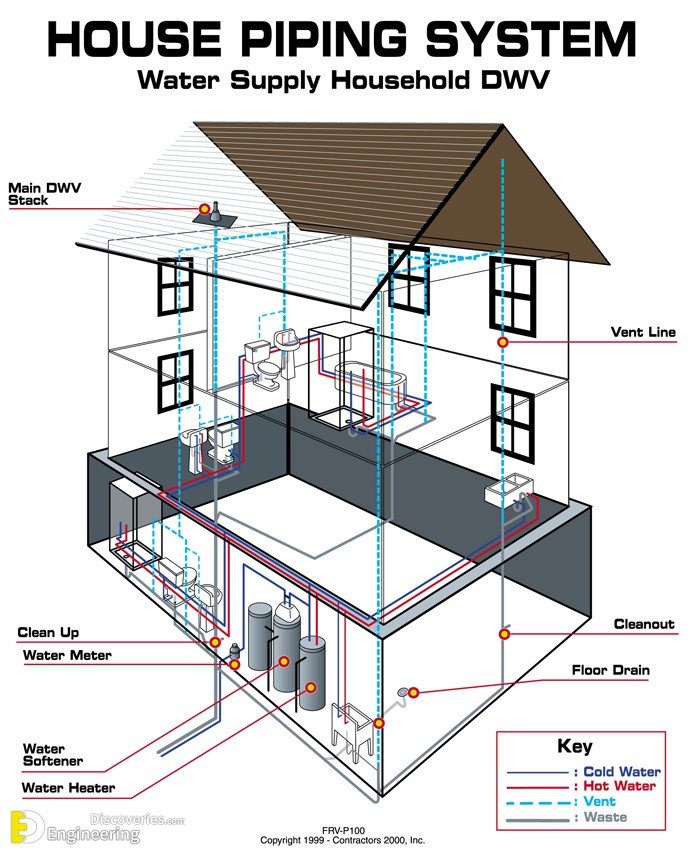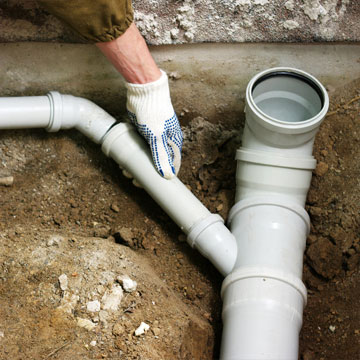The Design of Your Home's Plumbing System Explained
The Design of Your Home's Plumbing System Explained
Blog Article
They are making a number of good points related to Exploring Your Homes Plumbing Anatomy in general in this content directly below.

Understanding exactly how your home's pipes system works is vital for every single home owner. From supplying clean water for drinking, cooking, and bathing to safely eliminating wastewater, a properly maintained pipes system is essential for your household's health and wellness and convenience. In this detailed overview, we'll discover the elaborate network that comprises your home's plumbing and offer tips on maintenance, upgrades, and dealing with typical issues.
Introduction
Your home's plumbing system is more than just a network of pipelines; it's a complicated system that ensures you have access to tidy water and effective wastewater elimination. Recognizing its elements and just how they work together can help you prevent costly repairs and ensure everything runs smoothly.
Standard Elements of a Pipes System
Pipelines and Tubes
At the heart of your pipes system are the pipelines and tubing that lug water throughout your home. These can be constructed from various materials such as copper, PVC, or PEX, each with its benefits in regards to longevity and cost-effectiveness.
Components: Sinks, Toilets, Showers, and so on.
Fixtures like sinks, toilets, showers, and bathtubs are where water is used in your house. Comprehending how these fixtures link to the plumbing system helps in detecting troubles and planning upgrades.
Shutoffs and Shut-off Factors
Shutoffs control the flow of water in your pipes system. Shut-off shutoffs are important during emergencies or when you require to make repairs, permitting you to separate parts of the system without interrupting water flow to the whole home.
Supply Of Water System
Main Water Line
The major water line links your home to the municipal water or an exclusive well. It's where water enters your home and is distributed to various components.
Water Meter and Pressure Regulatory Authority
The water meter procedures your water use, while a pressure regulator makes certain that water streams at a safe stress throughout your home's pipes system, stopping damage to pipelines and fixtures.
Cold Water vs. Warm water Lines
Comprehending the distinction in between cold water lines, which supply water straight from the main, and warm water lines, which lug warmed water from the water heater, aids in troubleshooting and preparing for upgrades.
Drain System
Drain Water Lines and Traps
Drain pipes lug wastewater away from sinks, showers, and commodes to the sewer or septic system. Traps stop sewer gases from entering your home and likewise catch debris that might cause blockages.
Air flow Pipelines
Ventilation pipelines allow air right into the drainage system, stopping suction that could slow down water drainage and trigger catches to empty. Appropriate air flow is essential for preserving the honesty of your plumbing system.
Value of Appropriate Drainage
Guaranteeing appropriate water drainage avoids back-ups and water damage. Frequently cleaning up drains pipes and maintaining catches can protect against pricey repairs and prolong the life of your plumbing system.
Water Heater
Sorts Of Water Heaters
Water heaters can be tankless or standard tank-style. Tankless heating units warm water as needed, while containers save warmed water for prompt usage.
Updating Your Pipes System
Factors for Updating
Updating to water-efficient components or changing old pipelines can boost water top quality, lower water costs, and raise the worth of your home.
Modern Pipes Technologies and Their Advantages
Discover modern technologies like clever leakage detectors, water-saving commodes, and energy-efficient water heaters that can conserve money and minimize ecological impact.
Cost Considerations and ROI
Determine the in advance prices versus lasting financial savings when considering plumbing upgrades. Numerous upgrades pay for themselves with minimized energy bills and fewer repair work.
Just How Water Heaters Attach to the Pipes System
Recognizing just how hot water heater connect to both the cold water supply and hot water distribution lines helps in diagnosing issues like insufficient hot water or leaks.
Maintenance Tips for Water Heaters
Routinely flushing your water heater to remove debris, inspecting the temperature level settings, and examining for leaks can prolong its lifespan and improve energy efficiency.
Usual Pipes Concerns
Leakages and Their Reasons
Leaks can take place due to aging pipelines, loose fittings, or high water pressure. Addressing leakages without delay protects against water damages and mold growth.
Obstructions and Clogs
Blockages in drains and toilets are often brought on by flushing non-flushable items or a build-up of oil and hair. Utilizing drainpipe screens and being mindful of what decreases your drains can avoid blockages.
Signs of Plumbing Problems to Watch For
Low tide stress, slow-moving drains pipes, foul odors, or uncommonly high water costs are signs of possible plumbing problems that need to be attended to quickly.
Plumbing Upkeep Tips
Routine Inspections and Checks
Set up yearly plumbing examinations to capture problems early. Search for indications of leaks, deterioration, or mineral buildup in taps and showerheads.
DIY Maintenance Tasks
Basic tasks like cleansing faucet aerators, checking for bathroom leaks making use of dye tablet computers, or protecting subjected pipes in chilly environments can avoid significant plumbing concerns.
When to Call an Expert Plumber
Know when a pipes issue needs professional know-how. Attempting intricate repair work without correct knowledge can cause even more damage and higher repair service costs.
Tips for Minimizing Water Use
Easy behaviors like repairing leakages promptly, taking much shorter showers, and running full loads of laundry and dishes can conserve water and reduced your utility costs.
Eco-Friendly Pipes Options
Take into consideration sustainable pipes materials like bamboo for floor covering, which is durable and environment-friendly, or recycled glass for countertops.
Emergency situation Preparedness
Actions to Take During a Pipes Emergency
Know where your shut-off shutoffs are located and just how to turn off the water in case of a burst pipeline or significant leak.
Significance of Having Emergency Situation Calls Useful
Keep call details for local plumbing technicians or emergency situation solutions readily available for fast feedback throughout a pipes situation.
Ecological Influence and Preservation
Water-Saving Components and Home Appliances
Setting up low-flow taps, showerheads, and toilets can dramatically reduce water use without sacrificing performance.
DIY Emergency Situation Fixes (When Relevant).
Temporary repairs like making use of air duct tape to patch a leaking pipe or putting a container under a leaking tap can lessen damages till a professional plumbing shows up.
Final thought.
Comprehending the makeup of your home's pipes system encourages you to preserve it successfully, conserving money and time on repair services. By complying with routine upkeep regimens and remaining notified regarding contemporary plumbing innovations, you can ensure your plumbing system runs effectively for many years to find.
Exploring Your Homes Plumbing Anatomy
Water Supply System
Main Water Line: This is where water enters your home from the municipal supply or a private well. Water Meter: Typically located near where the main water line enters the property, it measures the amount of water used. Shutoff Valve: It s crucial to know where this is in case of emergencies. It allows you to turn off the water supply to the entire house. Pipes and Fittings: These distribute water throughout your home. Materials can include copper, PVC, or PEX. Drain-Waste-Vent (DWV) System
Drains: Located in sinks, showers, and tubs, these carry wastewater away. Traps: U-shaped pipes under sinks that hold standing water, blocking sewer gases from entering the home. Vents: Pipes that lead from the DWV system to the outside, preventing vacuum formation and allowing gases to escape. Sewer Line: Carries all wastewater from the home to the municipal sewer system or a septic tank. Fixtures and Appliances
Sinks, Toilets, and Showers Dishwashers and Washing Machines Water Heaters Maintenance Tips
Regularly check for leaks in exposed pipes and around fixtures. Inspect the water heater annually for signs of wear. Clean drains and traps to prevent clogs and odors. Know how to shut off water to individual fixtures. When to Call a Professional
Major leaks or burst pipes Installation of new pipes or fixtures Septic tank issues Remodeling projects that involve plumbing changes Conclusion
Understanding the anatomy of your home's plumbing is key to maintaining a functional and efficient system. Regular checks and knowing when to call in the experts can save you time, money, and stress.
https://www.mavyn.com/blog/exploring-your-homes-plumbing-anatomy

Do you really like reading about Understanding Your Home's Plumbing Anatomy? Try leaving a review down below. We would be delighted to see your responses about this content. In hopes to see you back again soon. Sharing is good. Helping others is fun. Thank you so much for your time invested reading it.
Contact Report this page